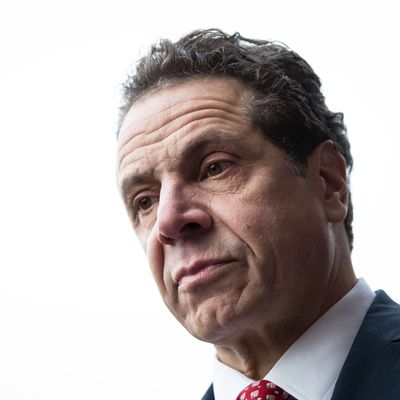
“The current state of decline is wholly unacceptable,” Governor Andrew Cuomo said Thursday about the New York’s transit system. “And we’re going to do something and we’re going to do something about it now.”
That something turned out to be a declaration of a state of emergency for the Metropolitan Transit Authority. The governor, who had lately been accused of skirting the subject of the crumbling subway system, said his new executive order would speed up the procurement process so it would “no longer be a tortured exercise to do business with the MTA.” That, in combination with a top-to-bottom review of the agency’s organizational structure and capital plan, and an extra $1 billion in state funds for the capital plan, would be the first step toward tackling the massive task of upgrading and repairing the city’s public-transit infrastructure.
Cuomo’s recognition of the problems facing the system and its riders was a welcome development. “It’s an acknowledgment that there are serious problems and, secondly, it’s an acknowledgement by the governor that he’s also in charge,” David Bragdon, executive director of the Transit Center, told Daily Intelligencer. “Those are really welcome. It’s different than even a month ago when there was a little bit of denial about both of those points.” The question now is what comes next, and whether Cuomo’s declaration — and his extra cash — will spur the necessary investments and upgrades within the system. And if the notoriously slow MTA can equip itself to handle those challenges. “The tougher issue and what remains to be seen is, is there a willingness to change the culture of the agency,” Bragdon explained.
Cuomo’s latest order could potentially at least spark that shake-up. The order puts on hold certain laws and regulations relating to how the MTA does business — acquiring new equipment, say, or soliciting requests for proposals (RFPs); all the bureaucratic “red tape” that tends to slows the agency down. Dave Friedfel, the director of state studies with the Citizens Budget Commission, confirmed what most subway riders probably already know — that generally speaking, the MTA has a fairly long procurement process. Part of that is to make sure things are “bid appropriately,” he says, but “some of the issues come from the fact that it is very specific to the MTA. They can’t buy things off the shelf.” So, Friedfel said, it makes some sense to try to pare back some of the processes “to jump-start some of the necessary repairs.”
Governor Cuomo issued a similar executive order in 2013, in response to Superstorm Sandy infrastructure repairs — though the MTA’s current situation is a bit different. But like most emergency orders, this latest one expires after 30 days, and the governor’s office said there’s the possibility it could be renewed again, and again, as necessary. It will be impossible, no matter how much red tape gets slashed, to fix what ails the subway in a month. But there’s also a lot the MTA can do internally to streamline operations and make itself more efficient within the current rules. Friedfel suggested this 30-day reprieve is the time to test those out. “The suspension of the rules should not be long-term,” Friedfel explained, “The procurement process is there to help the MTA accomplish its goals. It should be revised in the long term and not ignored.”
Cuomo has also ordered the new (and returning) MTA chairman Joe Lhota to complete an organizational review in 30 days, and to reevaluate the capital plan in 60 days. “Very simple, what do we need?,” Cuomo said. “How do we get it? How much will it cost? And how do we expedite the entire process?” Such evaluations, Bragdon said, are a healthy thing, but “it’s happened before. What hasn’t happened is the follow through.” Lhota comes to the job with experience, and he was widely praised for getting the subways back online after Hurricane Sandy (before leaving to launch an ultimately unsuccessful campaign for mayor). He told the New York Times that customer communication, new technology, and training personnel would likely be key priorities in the short term.
And, of course, the MTA needs resources to make all these improvements. Cuomo’s extra $1 billion is in addition to the $8.3 billion the state has already committed to the $32 billion in the 2015–2019 plan. But just $5.4 billion of the state’s contribution has been appropriated so far, and this extra $1 billion will require approval from the state legislature.
On Friday morning, once again, subway riders faced delays because of a train mechanical failure and an incident at Whitehall tied up the Broadway lines. Emergency declaration or no, there’s a long way to go to fix the subway. “The governor’s announcement is a significant political step forward,” said John Raskin, the executive director of the Riders Alliance. But Raskin cautioned, even though the governor is taking responsibility for the problem, the pressure can’t be taken off. “The next step is really for the governor to put forth a credible plan to fix the subway, fund the needed improvements, and then use his leadership to get the plan implemented.”





























